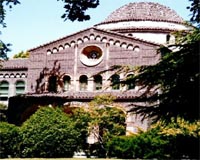 |
Nakhon Pathom, Thailand (AFP) Jan 2, 2009 Twelve-year-old Matoha Dosare was born with no right leg, but thanks to recycled soft drink cans and some old stockings, he now has a new limb and new-found independence. He is one of thousands of people given artificial limbs by the Prostheses Foundation, which uses unique techniques and some salvaged materials to provide cheaply-made prosthetics to Thais who have nowhere else to go. Matoha's local hospital in the far southern Yala province could not keep up building complicated new legs to match his growth spurts, so the schoolboy travelled to a temple in Nakhon Pathom, a province just west of Bangkok. "If he doesn't have that leg, I have to carry him to the restroom and do everything for him," said Matoha's mother, 46-year-old Menah Jeloh. "Now he can do it by himself." Matoha has had three new legs fitted in the last two years, with the metal in the joints coming from the donated bottle caps and tins. The nylon from the stockings is used in the sculpting process to help form the legs. The Prostheses Foundation was founded in 1992 with a royal grant, and goes to hospitals and temples throughout the kingdom to give people the free legs. Foundation vice chairman Thamrongrat Keokan said that the people they help are missing limbs for a variety of reasons, including car accidents, birth defects, diabetes and, along the border areas, landmines. In 17 years, the foundation says it has given away more than 30,000 legs, and once eared a place in the Guinness Book of World Records for producing more than 600 legs in one year. It is the recycled materials that make the project workable, Thamrongrat said, as they they keep costs down and allow the foundation to make and distribute more legs. The foundation asks people to donate materials that can be used in the limbs, such as beer cans and aluminium pots. A prosthetic for below the knee costs the foundation 1,000 baht (about 28 dollars) to make, Thamrongrat said. It would cost the government 10,000 baht to build a similar one. And unlike hospitals, the foundation provides it legs free to patients. Low cost, however, does not mean low quality. "Some elements here are the best I've seen in the world," said biomedical engineering professor Jon Sensinger, who brought about 35 of his students from a Bangkok university to the distribution. "Other parts, I may not agree with the design, but I understand why the sacrifices were made." One such sacrifice is the use of aluminium rather than steel. It is lighter and available from the donated cans, but it does wear out faster. Nevertheless, these the money-saving techniques allow people to get legs they would otherwise have to live without, and they give the makers an opportunity to experiment with design. One prosthetic offered is the "farmer's leg," which uses more steel and ends in a stump with tire treads on the bottom rather than a false foot. This was created because farmers complained the foot got stuck in the mud, Thamrongrat said. Nature inspired the solution to this problem. "We made it like an elephant leg so it goes in (the mud) and comes out," he told AFP. Farmer Waew Tangthiang, 57, said the unique leg will let him work again for the first time in two years. Since he lost his left leg below the knee to diabetes, his wife has been unable to keep the farm profitable. Bangkok resident Anong Chao, 65, said she too hopes her new leg will let her earn some money and regain her independence. "If I get the new artificial leg, I can do something to earn my living, like be a food vendor," Anong said. "I can do something other than sitting in a wheelchair." Share This Article With Planet Earth
Related Links Powering The World in the 21st Century at Energy-Daily.com
 Long Beach CA (SPX) Jan 02, 2009
Long Beach CA (SPX) Jan 02, 2009The California State University (CSU) has been recognized by the state's Flex Your Power campaign for reducing power use by up to 3 megawatts (MW) during critical demand through the summer of 2008. |
|
| The content herein, unless otherwise known to be public domain, are Copyright 1995-2007 - SpaceDaily.AFP and UPI Wire Stories are copyright Agence France-Presse and United Press International. ESA Portal Reports are copyright European Space Agency. All NASA sourced material is public domain. Additional copyrights may apply in whole or part to other bona fide parties. Advertising does not imply endorsement,agreement or approval of any opinions, statements or information provided by SpaceDaily on any Web page published or hosted by SpaceDaily. Privacy Statement |